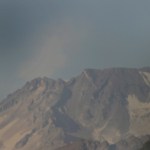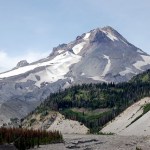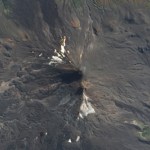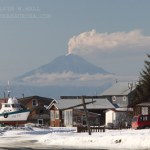volcanic hazards
Descabezado Grande, Chile showing increased fumarolic activity in 2009.
Well, if they didn't have enough already between Llaima and Chaiten, another volcano in southern Chile has started erupting. Descabezado Grande (roughly translated: "The Big Beheaded One") has erupted or is showing of eruption (in spanish and NOTE that the picture in the article is of Llaima, NOT, I repeat, NOT Descabezado Grande ... grrr) but details are scant on the actual activity. However, scientists from the SERNAGEOMIN are headed to the area to evaluate the volcano - hopefully the reports are accurate. So far,…
This is another busy Wednesday for me as the Geology Dept. at UC Davis will be hosting Dr. Jacob Lowenstern, USGS scientist and director of the Yellowstone Volcano Observatory. He will be giving the weekly seminar, along with another talk in the evening at Sacramento State as part of the Volcanological Society of Sacramento meeting (which is open to the public for those of you around Sacramento). I'm especially excited for the evening talk entitled "Domestic volcanic unrest and activity in 2009: Kilauea, Redoubt, Yellowstone and Washington, D.C.". I'll be sure to report any fun tidbits.
For…
Shiveluch volcano in Russia. Image courtesy of KVERT.
Over this past weekend, Shiveluch in Kamchatka experienced a plinian eruption, producing a 7-km / 23,000 foot ash column. The NASA Terra satellite caught a great image of the ash plume over the snowy landscape of the Kamchatkan Peninsula on April 26, 2009. KVERT issued these comments on the current eruptive activity:
Seismic activity of the volcano slightly decreased but continues to
remain at high levels. A continuous spasmodic volcanic tremor and
series of weak shallow events continue to registering at volcano at
present.
According to…
Mt. Slamet, Indonesia, with agricultural fields in the foreground.
I'll be brief, mostly because I'm still lost in a haze of jetlag and allergies, but ...
Mt. Slamet on the island of Java in Indonesia is showing signs of a "major eruption". Preparations have begun by the Indonesian government to evacuate people in the event that the volcano erupts, however, it is unclear when that might be. Agus Budianto, head of the volcanology unit at the Bandung, West Java-based Volcanology and Disaster Mitigation Agency, said this about the current activity at the volcano:
"Even though the earthquake…
Back in the days when Eruptions was on Wordpress, I held a vote about what volcano should be the next to be profiled on this blog. The winner was Mt. Hood in Oregon, and after much waiting, the profile is here. I will actually be out of town until Monday doing some house shopping in this little town. Enjoy this look at one of the most picturesque (and hazardous - #4 in fact) volcanoes in the lower 48 states.
VOLCANO PROFILE: MT. HOOD
Mt. Hood, Oregon in August 2008 taken by Erik Klemetti.
Location: Oregon, U.S.A.
Height: 3,426 m / 11,240 ft
Geophysical location: Along the Cascade arc where…
Satellite image of the island of Tenerife with the main vent of the volcano (El Teide) in the central part of the island.
I will be out of town for the next few days, so I thought I'd leave this thread for breaking volcano news that any of you Eruptions readers notice.
However, I couldn't pass up the opportunity to point out some abysmal science journalism before I go. I mean, I shouldn't have been surprised considering this is from the The Sun(UK), but, come on, could you at least put some effort in?
The article in question pertains to the recent controversy about the level of danger people…
UPDATED 3:30PM Pacific: The Associated Press has put up some silent video of the lava flows reaching the ocean at night
The Geophysical Institute in Ecuador is reporting that the eruption at Fernandina in the Galapagos has intensified over the last 24 hours. Heck, the image accompanying the report looks downright apocalyptic:
Now, I'm actually not entirely sure what is being shown in this image. There is no caption, either. My guess is that this is an ocean entry for one of the lava flows, considering the steam and what looks to be water in the foreground. Of course, I have no idea if the…
Has a week gone by already? It is time for another USGS/Smithsonian GVP Weekly Volcano Activity Report.
Highlights (beyond Fernandina, Pagan and Redoubt) include:
A new underwater eruption at NW-Rota 1 in the Mariana Islands.
Increasing seismicity and incandescence from the rhyolite domes forming at Chaiten, Chile.
A spike in sulfur dioxide emissions from Kilauea, Hawai'i to 700 tonnes/day (up from a 2003-07 average of 150 tonnes/day).
4.5-7.5 km / 15-26,000 foot ash columns produced at Shiveluch in Kamchatka from new lava dome.
Continued dome growth and ~6 km / 26,000 foot ash columns from…
Mt. Baker in Washington. Image taken by John Scurlock.
Eruptions reader Robert Somerville brought to my attention the Mount Baker Volcano Research Center, a "clearinghouse for research on Mt. Baker" in Washington state. The center is a non-profit organization that is affiliated with the Geology Department at Western Washington University - and from the looks of the website, they've already done a great job in compiling a lot of information about Mt. Baker, including an excellent eruptive history of the volcano. Mt. Baker is one of the most active Cascade volcanoes, with active fumarolic…
Fernandina in the Galapagos erupting in April 2009. Image courtesy of NASA.
The latest reports about the ongoing eruption at Fernandina are both coming and going. Reports from officials in the Galapagos National Park suggest that the eruption was become more intense (in spanish), while later reports from the Geophysical Institute in Ecuador say that the eruption is waning. Both reports might be true and reflect the volatile nature of the eruption, but overall it seems that the wildlife (that probably is used to this sort of thing anyway) hasn't been effected too much by the eruption.
Well, after lamenting the slow volcano news, things are beginning to pick up again. Beyond the news of a potential increase in activity at Anak Krakatau, there are a few other newsworthy bits that have come up:
Mt. Kerinci in Indonesia
Mt. Kerinci in Indonesia is showing signs of eruption. The volcano is the highest mountain on the island of Sumatra, reaching 3,800 m / 12,400 feet and last erupted in March 2008. Its volcanic activity is marked by small (VEI 2) explosions of ash and tephra. Currently, the volcano is experiencing increased tremors and minor explosions that rained ash on a tea…
Anak Krakatau erupting in 2007.
There is a report out tonight that activity might be increasing at Anak Krakatau in Indonesia, however, it is unclear whether it is actually increasing or not. People are evacuating the coastal area of the Sunda Strait to Bandarlampung in fear that a major eruption of the volcano is on the horizon. However, the Volcanology and Geological Disaster Mitigation Center (PVMBG) in Indonesia has not changed the alert status at Anak Krakatau and it remains at 2 of 4 (~Orange Status). The volcano has been erupting almost constantly for the last few years, producing…
It has been rather quiet on the volcano-front in the last week. Redoubt and Llaima (in spanish), after a few weeks of intense eruption, are both back on Orange Alert. News of the eruptions from Hunga Tonga Hunga Ha'apai and Fernandina is rather sparse in the details. The news of volcanism in 2009 seems to have settled down.
A few tidbits I caught over the weekend:
Chaiten
Damage wrought by the eruption of Chaiten on the town of Chaiten in Chile, taken in early December 2008. Image courtesy of the NASA Earth Observatory.
Don't you feel like you're read this sort of story before after other…
The weekend is rolling in and I might end up spending most of it in the 90+ degree California weather, so unless something big comes up (volcanically), I'll leave you with a few news bits.
Llaima
Llaima in April 2009. Image courtesy of the NASA Earth Observatory
This is a true color image of Llaima in Chile, provided by the great folks at the NASA Earth Observatory. You can clearly see the dark grey new tephra on the main summit cone along with the grey ash covering the snow on the southwestern part of the volcano (north is up). A few other fun features are some smaller parasitic cones in…
Redoubt with a prominent steam plume on April 7,2009. Image courtesy of Robert Cole/AVO
Eruptions reader Brian just pointed out that AVO has posted a new webcam (well, a redirectly webcam) for the volcano and I thought it deserved its own post. This new angle gets you right up to the new dome forming on the volcano. The Hut webcam is now zoomed into the area where new magma is extruding - mostly passively - from this eruption. From this vantage point, when conditions permit - you might be able to get a good view of the dome-collapse block & ash flows that typically accompany silicic dome…
Fissure vent eruption from Fernandina in the Galapagos Islands.
In news that comes as a surprise to no one, the current eruption on Fernandina in the Galapagos is having some adverse effect on the wildlife in the Pacific archipelago. Numerous dead fish and sea lions have been seen in the ocean near the actively erupting volcano - now, what exactly is causing the deaths is more speculative. I would imagine with the large plume being produced by the volcano, along with the lava flows reaching the ocean, that volcanic gases and the lava's interaction with the sea water might be the leading…
Mount Pagan in the Mariana Islands erupting on April 15, 2009. Image courtesy of the NASA Earth Observatory.
Up until fairly recently, a lot of volcanoes got away with erupting without anyone knowing the better. However, with all the "eyes in the sky" we have these days, even remote oceanic volcanoes get caught in the act of erupting. Case in point is this image (above) of Mt. Pagan in the Mariana Islands erupting. It was captured by the MODIS satellite yesterday and it shows a health ash plume emanating from the volcano. Pagan is an oceanic stratovolcano on the sparsely populated island of…
Here's the latest Global Volcanism Program activity report for worldwide volcanism. Some of the highlights (beyond Fernandina and Llaima) include:
Vulcanian-style eruptions at Sakurajima, Japan. And guess what? There is a Sukarajima webcam! {Hat tip to Eruptions reader Jodie Morris for this link}.
Strombolian-style explosions and avalanches associated with lava flows at Arenal, Costa Rica.
A 10,000 foot / 3,000 meter ash plume from Dukono in Indonesia.
Satellite imagery exposed a thermal anomaly in the dome at Shiveluch on the Kamchatka Peninsula.
Just a quick note before I'm off to this ...
Llaima
The SERNAGEOMIN is evaluating whether the alert level at Llaima should be lowered to Yellow in the near future (in spanish). Seismic acitivity at the volcano have come down since the eruptions started a few weeks ago and most of the activity now seems to be fumarolic in nature.
Popocatépetl
Popo (as it is also called) continues to produce steam/gas plumes (in spanish), 5 in one day on Monday of this week. However, all the other usual volcanic monitoring parameters (seismicity and the like) are unchanged according to Cenapred (National…
Redoubt from Ninilchik, AK. Image courtesy of Calvin Hall.
It has been a few days since we've talked about Redoubt. Well, it might be because the volcano has settled down for the past week, to the point that AVO put the volcano back to Orange/Watch status last week and hasn't had to go back to Red/Warning since. This is not to say the Redoubt is quiet, on the contrary, there is still elevated seismicity, an almost-constant steam/ash plume up to 15,000 feet / 5,000 meters and most importantly, the new dome (below) is still growing near the summit. The system has been actively degassing carbon…




